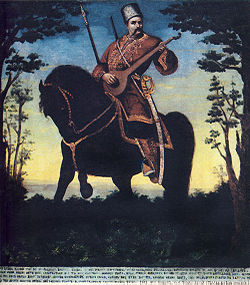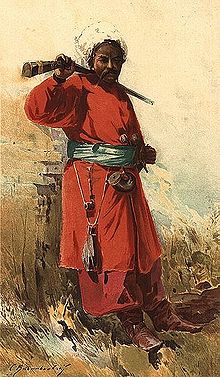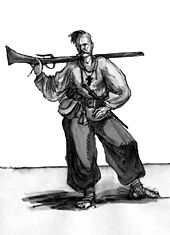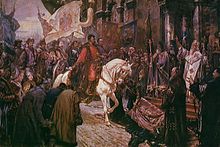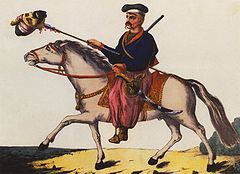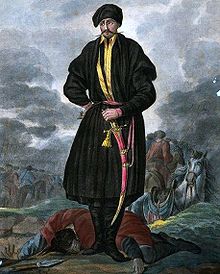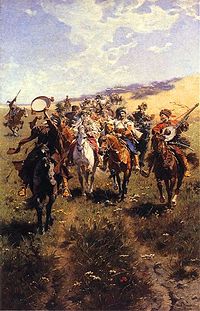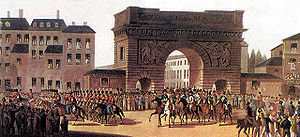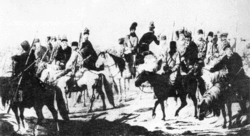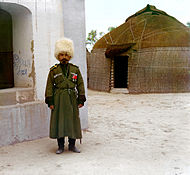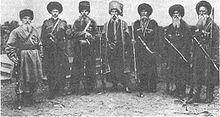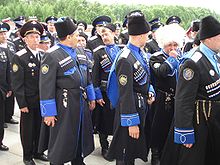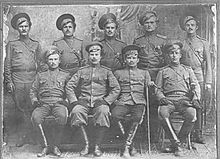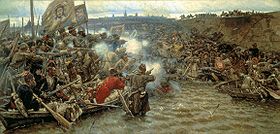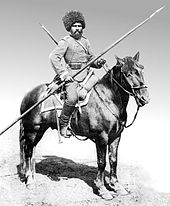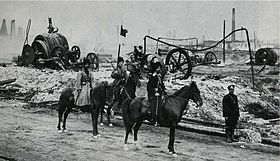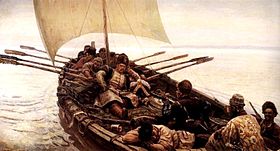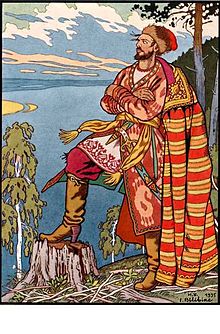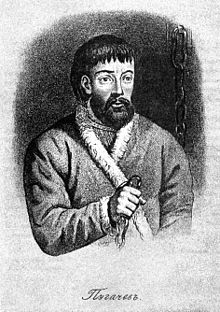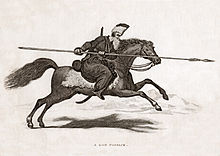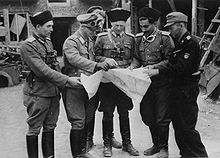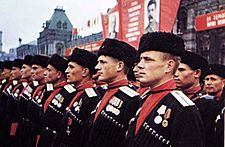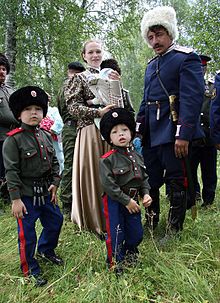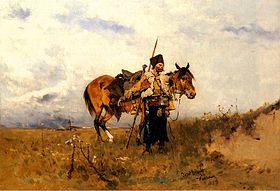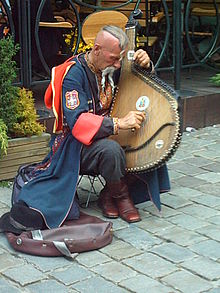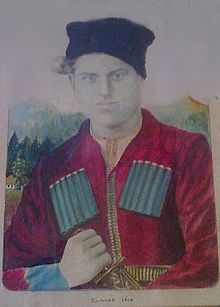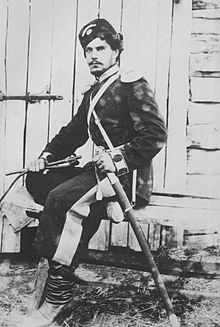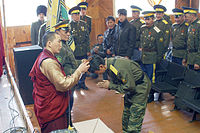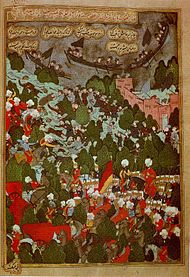- Cossacks
-
Part of a series on Cossacks 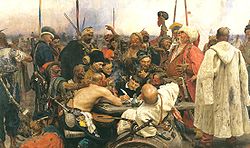
Cossack hosts Azov · Black Sea · Buh · Caucasus · Danube · Don · Volga · Ural · Terek · Kuban · Orenburg · Astrakhan · Siberian · Baikal · Amur · Semirechye · Ussuri · Zaporozhia Other groups Danube (Sich) · Tatar Cossacks · Nekrasov · Turkey · Jewish Cossacks History Registered Cossacks · Kosiński Uprising · Nalyvaiko Uprising · Khmelnytsky Uprising · Hadiach Treaty · Hetmanate · Colonisation of Siberia · Bulavin Rebellion · Pugachev's Rebellion · 1st Cavalry Army · Decossackization · Betrayal · XV SS Cossack Cavalry Corps · 1st Cossack Division Famous Cossacks Bohdan Khmelnytsky · Petro Sahaidachny · Ivan Vyhovsky · Petro Doroshenko · Ivan Mazepa · Ivan Sirko · Yemelyan Pugachev · Stenka Razin · Yermak Timofeyevich Cossack terms Ataman · Hetman · Kontusz · Papakhi · Plastun · Szabla · Shashka · Stanitsa · Yesaul Cossacks (Ukrainian: Козаки́, Kozaky, Russian: Казаки́, Kazaki) are a group of predominantly East Slavic people who originally were members of democratic, semi-military communities in what is today Ukraine and Southern Russia inhabiting sparsely populated areas and islands in the lower Dnieper[1] and Don basins and who played an important role in the historical development of those nations.
The origins of the first Cossacks are disputed. Traditional historiography dates the emergence of Cossacks to the 14th to 15th centuries. Towards the end of the 15th century, the Ukrainian Cossacks formed the Zaporozhian Sich centered around the fortified Dnipro islands. Initially a vassal of Poland-Lithuania, the increasing social and religious pressure from the Commonwealth caused them to proclaim an independent Cossack Hetmanate, initiated by a rebellion under Bohdan Khmelnytsky in the mid-17th century. Afterwards, the Treaty of Pereyaslav brought most of the Ukrainian Cossack state under Russian control for the next 300 years.[2]
The Don Cossack Host, which had been established by the 16th century,[3] allied itself with the Tsardom of Russia. Together they began a systematic conquest and colonisation of lands in order to secure the borders on the Volga, the whole of Siberia (see Yermak Timofeyevich), the Yaik and the Terek Rivers. By the 18th century, Cossack hosts in the Russian Empire served as buffer zones on her borders. However, the expansionist ambitions of the empire relied on ensuring the loyalty of Cossacks, which caused tension with their traditional independent lifestyle. In the 17th and 18th centuries this resulted in rebellions led by Stenka Razin, Kondraty Bulavin and Yemelyan Pugachev. In extreme cases, whole Hosts could be dissolved, as was the fate of the Zaporozhian Sich in 1775. By the end of the 18th century, Cossacks were transformed into a special social estate (Sosloviye); they served as border guards on national and internal ethnic borders (as was in the case in the Caucasus War) and regularly supplied men to conflicts such as the numerous Russo-Turkish Wars. In return, they enjoyed vast social autonomy. This caused them to form a stereotypical portrayal of 19th century Russian Empire abroad and her government domestically.
During the Russian Civil War, Cossack regions became centres for the Anti-Bolshevik White movement, a portion of whom would form the White emigration. The Don and Kuban Cossacks even formed short-lived independent states in their respective territories. With the victory of the Red Army, the Cossack lands were subjected to famine, and suffered extensive repressions. After the dissolution of the Soviet Union, the Cossack lifestyle and its ideas have made a return in Russia. Special Cossack units exist in the Russian Military, while Cossacks also have a parallel civil administration and police duties in their home territories that have become an integral part of contemporary society. There are Cossack organizations in Kazakhstan, Ukraine and other countries.
Contents
Name
Vassmer's etymological dictionary traces the name to an Old East Slavic козакъ, kozak, originally from Cuman kаzаk - a free man, specifically an individual who could not find his appropriate place in society and went into the steppes, where he acknowledged no authority. It is first attested in a Cuman dictionary the 13th century.[4][5] The English word is attested from 1590. The ethnonym Kazakh is from the same Turkic root.[6][7][8] Such adventurers or Qazaqlar served as border guards in the Khanate of Kazan.[citation needed]
Early history
It is not clear when the Slavic people started settling in the lower reaches of major rivers such as the Don and the Dnieper. It is unlikely it could have happened before the 13th century, when the Mongols broke the power of the Bulgars on that territory. It is known that they inherited a lifestyle that persisted there long before, such as those of the Turkic Cumans and the Circassian Kassaks .[9]
Early "Proto-Cossack" groups very likely came into existence within the territories of today's Ukraine in the mid-13th century as the Golden Horde influence grew weak. Non-mainstream theories have ascribed their earlier existence to as early as the tenth century.[10] Some historians suggest that the Cossack people were of mixed ethnic origins, descending from Russians, Ukrainians, Poles, Turks, Tatars, and others who settled or passed through the vast Steppe.[11] However some turkologists argue that cossacks are descendants of native Cumans of Ukraine, who lived there long ago before Mongol invasion.[12]
In the midst of the growing Moscow and Lithuanian powers, new political entities had appeared in the region such as Moldavia and the Crimean Khanate. In 1261 some Slavic people living in the area between the Dniester and the Volga were mentioned in Ruthenian chronicles. Historical records of the Cossacks before the 16th century are scant as the history of the Ukrainian lands in that period for various reasons. It is known that Don Cossacks, in 1380, gave the icon of the Virgin Mary to the Dmitry Donskoy.[citation needed]
In the 15th century, the Cossack society was described as a loose federation of independent communities, often forming local armies, entirely independent from the neighbouring states (of, e.g., Poland, Grand Duchy of Moscow or the Khanate of Crimea).[13] According to Hrushevsky the first mentioning of cossacks could be found already in 14th century, however they were either of Turkic or undefined origin. He states that they (cossacks) could have been descendants from the Berlad territory (today in Romania) that was part of the Grand Duchy of Halych, brodniki, or even the long forgotten antes. Cossacks were a sort of a self-defense formations organized against various raids conducting by neighbors.[14] Already in 1492 the Crimean Khan was complaining that the Kiev and Cherkasy cossacks attacked his ship near Tighina (Bender) and the Grand Duke of Lithuania Alexander I promised to find the guilty among the cossacks. Sometime in the beginning of 16th century there have appeared the old Ukrainian Ballad of Cossack Holota about a cossack near Kiliya.
By the 16th century these Cossack societies merged into two independent territorial organisations as well as other smaller, still detached groups.
- The Cossacks of Zaporizhia, centered around the lower bends of Dnieper, inside the territory of modern Ukraine, with the fortified capital of Zaporozhian Sich. They were formally recognised as an independent state, the Zaporozhian Host, by a treaty with Poland in 1649.
- The Don Cossack State, on the river Don, separated from the Grand Duchy of Moscow by the Nogai states, vassals of the Ottoman Empire. The capital of the Don Cossack State was Cherkassk, later moved to Novocherkassk.
Less well-known are the Polish Cossacks (Kozacy) and the Tatar Cossacks (Nağaybäklär). The term 'Cossacks' was also used for a type of light cavalry in the army of the Polish-Lithuanian Commonwealth.
Ukrainian Cossacks
Zaporozhian Cossacks
The cossacks, who lived on the steppes of Ukraine, are a well known group of Cossacks. Their numbers increased greatly between the 15th and 17th centuries, usually led by Ruthenian boyar or prince nobility, various Polish starostas, merchants, and runaway peasants from the area of the Poland-Lithuania Commonwealth. The Zaporozhian Cossacks played an important role in European geopolitics, participating in a series of conflicts and alliances with the Polish-Lithuanian Commonwealth, Russia, and the Ottoman Empire. In 1552 on the banks of the Lower Dnieper was formed the first recorded Zaporizhian Host when Dmytro Vyshnevetsky built a fortress on the island of Khortytsia. As a result of the Khmelnytsky Uprising in the middle of the 17th century the Zaporozhian Cossacks managed to briefly create an independent state, which later became the autonomous Cossack Hetmanate, a suzerainty under protection of the Russian Tsar but ruled by the local Hetmans for half a century. In the later half of the 18th century the Zaporozhian Host was destroyed by the Russian authorities. Some Cossacks moved to the Danube delta region and later the Kuban region. After 1828 most of the Danubians had moved first to the Azov and later to the Kuban regions. Although today some[citation needed] of the Kuban Cossacks and their descendants do not consider themselves Ukrainians by nationality, the language most of descendants speak is a dialect of central Ukrainian and their folklore is significantly Ukrainian.
The Zaporozhians were renowned for their raids against the Ottoman Empire and its vassals, although they sometimes war looted other neighbors as well. Their actions increased tension along the southern border of the Polish-Lithuanian Commonwealth, which resulted in almost a constant low-level warfare taking place in those territories for almost the entire existence of the Polish-Lithuanian Commonwealth.
After being asked in 1539 by the Ottoman Sultan to restrain the Cossacks, the Grand Duke Vasili III of Russia replied: "The Cossacks do not swear allegiance to me, and they live as they themselves please."[citation needed] In 1549, Tsar Ivan the Terrible replied to a request of the Turkish Sultan to stop the attacks of the Don Cossacks, stating, "The Cossacks of the Don are not my subjects, and they go to war or live in peace without my knowledge."[citation needed] Similar exchanges passed between Russia, the Ottoman Empire and the Polish-Lithuanian Commonwealth, each of which tried to exploit Cossack warmongering for its own purposes. In the 16th century, with the dominance of the Polish-Lithuanian Commonwealth extending south, the Zaporozhian Cossacks were mostly, if tentatively, regarded by the Polish-Lithuanian Commonwealth as their subjects.[15] Registered Cossacks were a part of the Commonwealth army until 1699.
Around the end of the 16th century, relations between the Polish-Lithuanian Commonwealth and the Ottoman Empire, which were not cordial to begin with, were further strained by increasing Cossack aggression. From the second part of the 16th century, Cossacks started raiding Ottoman territories. The Polish government could not control the fiercely independent Cossacks, but since they were nominally subjects of the Commonwealth, it was held responsible for the raids by their victims. Reciprocally, the Tatars living under Ottoman rule launched raids into the Commonwealth, mostly in the sparsely inhabited southeast territories. Cossack pirates, however, were raiding wealthy merchant port cities in the heart of the Ottoman Empire, which were just two days away by boat from the mouth of the Dnieper River. By 1615 and 1625, Cossacks had even managed to raze townships on the outskirts of Constantinople, forcing the Ottoman Sultan to flee his palace.[16] Consecutive treaties between the Ottoman Empire and the Polish-Lithuanian Commonwealth called for both parties to keep the Cossacks and Tatars in check, but enforcement was almost non-existent on both sides. In internal agreements, forced by the Polish side, Cossacks agreed to burn their boats and stop raiding. However, boats could be rebuilt quickly, and the Cossack lifestyle glorified raids and booty. During this time, the Habsburg Empire sometimes covertly employed Cossack raiders to ease Ottoman pressure on their own borders. Many Cossacks and Tatars shared an animosity towards each other due to the damage done by raids from both sides. Cossack raids followed by Tatar retaliation, or Tatar raids followed by Cossack retaliation, were an almost regular occurrence. The ensuing chaos and string of retaliations often turned the entire southeastern Polish-Lithuanian Commonwealth border into a low-intensity war zone and led to escalation of Commonwealth-Ottoman warfare, from the Moldavian Magnate Wars to the Battle of Cecora and Wars in 1633–1634.
Cossack numbers expanded with peasants escaping serfdom in the Polish-Lithuanian Commonwealth. Attempts by the szlachta to turn the Zaporozhian Cossacks into serfs eroded the Cossacks' once fairly strong loyalty towards the Commonwealth. Cossack ambitions to be recognised as equal to the szlachta were constantly rebuffed, and plans for transforming the Polish-Lithuanian Two-Nations Commonwealth into Three Nations (with the Ruthenian Cossack people) made little progress due to the Cossacks' unpopularity. The Cossacks' strong historic allegiance to the Eastern Orthodox Christianity put them at odds with the Catholic-dominated Commonwealth. Tensions increased when Commonwealth policies turned from relative tolerance to suppression of the Orthodox church, making the Cossacks strongly anti-Catholic, which at the time was synonymous with anti-Polish.
Registered Cossacks
The waning loyalty of the Cossacks and the szlachta's arrogance towards them resulted in several Cossack uprisings against the Polish-Lithuanian Commonwealth in the early 17th century. Finally, the King's adamant refusal to cede to the Cossacks' demand to expand the Cossack Registry was the last straw that prompted the largest and most successful of these: the Khmelnytsky uprising that started in 1648. The uprising became one of a series of catastrophic events for the Commonwealth known as The Deluge, which greatly weakened the Polish-Lithuanian Commonwealth and set the stage for its disintegration 100 years later.
The rebellion ended with the 1654 Treaty of Pereyaslav in which Cossacks pledged their loyalty to the Russian Tsar with the latter guaranteeing Cossacks his protection, recognition of Cossack starshyna (nobility) and their autonomy under his rule, freeing the Cossacks from the Polish sphere of influence.[17] The last, ultimately unsuccessful, attempt to rebuild the Polish-Cossack alliance and create a Polish-Lithuanian-Ruthenian Commonwealth was the 1658 Treaty of Hadiach, which was approved by the Polish King and Sejm as well as by some of the Cossack starshyna, including Hetman Ivan Vyhovsky.[18] The starshyna were, however, divided on the issue and the treaty had even less support among Cossack rank-and-file; thus it failed.
Under Russian rule the Cossack nation of the Zaporozhian Host was divided into two autonomous republics of the Grand Duchy of Moscow: the Cossack Hetmanate, and the more independent Zaporizhia. These organisations gradually lost their autonomy, and were abolished by Catherine II by the late 18th century. The Hetmanate became the governorship of Little Russia, and Zaporizhia was absorbed into New Russia. In 1775 the Zaporozhian Host was destroyed and high-ranking Cossack leaders were sent to Solovky or killed.
Black Sea, Azov and Danube Cossacks
With the destruction of the Zaporozhian Sich, many of these Cossacks settled in the area of the Danube river and became known as the Black Sea cossacks. Others settled in the area north of the Azov Sea and became known as the Azov cossacks. Some of these Cossacks later were resettled to colonise the Kuban steppe which was a crucial foothold for Russian expansion in the Caucasus. Some however ran away across the Danube (territory under the control of the Ottoman Empire) to form a new host before rejoining the others in the Kuban.
During their stay there, a new host was founded which by the end of 1778 numbered around 12,000 Cossacks. Their settlement at the border with Russia was approved by the Ottoman Empire after the Cossacks officially vowed to serve the Sultan. Yet the conflict inside the new host of the new loyalty, and the political manoeuvres used by the Russian Empire, led to a split in the Cossacks. After a portion of the runaway Cossacks returned to Russia they were used by the Russian army to form new military bodies that also incorporated Greek Albanians and Crimean Tatars. However after the Russo-Turkish war of 1787–1792, most of them were incorporated into the Black Sea Cossack Host which moved to the Kuban steppes. Most of the remaining Cossacks that stayed in the Danube delta returned to Russia in 1828 and created the Azov Cossack Host between Berdyansk and Mariupol. In 1860 all of them were resettled to the North Caucasus and merged into the Kuban Cossack Host.
Russian Cossacks
The native land of the Cossacks is defined by a line of Russian/Ruthenian town-fortresses located on the border with the steppe and stretching from the middle Volga to Ryazan and Tula, then breaking abruptly to the south and extending to the Dnieper via Pereyaslavl. This area was settled by a population of free people practicing various trades and crafts.
These people, constantly facing the Tatar warriors on the steppe frontier, received the Turkic name Cossacks (Kazaks), which was then extended to other free people in northern Russia. The oldest reference in the annals mentions Cossacks of the Russian city of Ryazan serving the city in the battle against the Tatars in 1444. In the 16th century, the Cossacks (primarily those of Ryazan) were grouped in military and trading communities on the open steppe and started to migrate into the area of the Don (source Vasily Klyuchevsky, The course of the Russian History, vol.2).
Cossacks served as border guards and protectors of towns, forts, settlements and trading posts, performed policing functions on the frontiers and also came to represent an integral part of the Russian army. In the 16th century, to protect the borderland area from Tatar invasions, Cossacks carried out sentry and patrol duties, observing Crimean Tatars and nomads of the Nogai Horde in the steppe region.
The most popular weapons used by Cossack cavalrymen were usually sabres, or shashka, and long spears.
Russian Cossacks played a key role in the expansion of the Russian Empire into Siberia (particularly by Yermak Timofeyevich), the Caucasus and Central Asia in the period from the 16th to 19th centuries. Cossacks also served as guides to most Russian expeditions formed by civil and military geographers and surveyors, traders and explorers. In 1648 the Russian Cossack Semyon Dezhnyov discovered a passage between North America and Asia. Cossack units played a role in many wars in the 17th, 18th, and 19th centuries (such as the Russo-Turkish Wars, the Russo-Persian Wars, and the annexation of Central Asia).
During Napoleon's Invasion of Russia, Cossacks were the Russian soldiers most feared by the French troops. Napoleon himself stated "Cossacks are the best light troops among all that exist. If I had them in my army, I would go through all the world with them."[19] Cossacks also took part in the partisan war deep inside French-occupied Russian territory, attacking communications and supply lines. These attacks, carried out by Cossacks along with Russian light cavalry and other units, were one of the first developments of guerrilla warfare tactics and, to some extent, special operations as we know them today.
Western Europeans had had few contacts with Cossacks before the Allies occupied Paris in 1814. As the most exotic of the Russian troops seen in France, Cossacks drew a great deal of attention and notoriety for their alleged excesses during Napoleon's 1812 campaign.
Don Cossacks
There were several groups of different origin who came to be known as Cossacks and hence there are different theories of Don Cossack origin:
- Don Cossacks are run-away peasants. According to this theory Cossacks originated as bands of run-away peasants of different ethnic origins (Ruthenians, Turks, Germans etc.). The necessity of defending their lifestyle (piracy, unregulated fishing and hunting) and protecting their settlements from the attacks of Tatars, Mongols and other nomadic tribes that lived in the steppes of Southern Russia, forced these bands of escapees to organize into a military society. In exchange for protection of the Southern borders of medieval Russia, the Don Cossacks were given the privilege of not paying taxes and the tsar’s authority in Cossack lands was not as absolute as in other parts of Russia. The theory of Don Cossacks as run-away peasants implies that they colonized areas previously occupied by nomadic tribes and were first to establish permanent settlements in Don area such as villages (станицы) and cities.
- Don Cossacks are descendants of Kurgan people. The Kurgan hypothesis suggests that migration of people to Europe originated from the Southern steppes of what is now Russia and Ukraine. There are multiple remains of proto-Indo-European settlements on the territory of the Don Cossacks such as Miklajlovka, Skelja-Kamenolomnja, Liventsovka.[20] The borders of the Don Cossack land are in the very centre of territory once populated by the Kurgan people. The hypothesis suggests that Don Cossacks did not move to the steppes of Southern Russia from other parts of Europe, but rather that they are descendants of the Kurgan people that moved to this area from the Near East before further migration to Europe and India.
The theories, however, do not exclude one another. It is possible that Don Cossacks originated as descendants of Kurgan people and over time gave shelter to people of various ethnic origins that for different reasons escaped from their homeland to the Don Cossacks' territory. The reasons would be:
Kuban Cossacks
Kuban Cossacks (Russian: Кубанские кaзаки, Kubanskiye Kаzaki) or Kubanians (кубанцы) are Cossacks who live in the Kuban region of Russia. Although numerous Cossack groups came to inhabit the Western Northern Caucasus most of the Kuban Cossacks are descendants of the Black Sea Cossack Host, (originally the Zaporozhian Cossacks) and the Caucasus Line Cossack Host.
A distinguishing feature from other Russian Cossacks is the Oseledets haircut popular among many Kubanians. This is due to their traditional Ukrainian roots, going back to the Zaporizhian Sich.
Terek Cossacks
The Terek Cossack Host (Russian: Терское казачье войско) was a Cossack host created in 1577 from free Cossacks who resettled from the Volga to the Terek River. In 1792 it was included in the Caucasus Line Cossack Host and separated from it again in 1860, with the capital of Vladikavkaz. In 1916 the population of the Host was 255,000 within an area of 1.9 million desyatinas. Many of the early members of the Terek Cossacks were Ossetians.[1]
Yaik Cossacks
The Ural Cossack Host was a cossack host formed from the Ural Cossacks, cossacks settled by the Ural River. Their alternative name, Yaik Cossacks, comes from the old name of the river. The Ural Cossacks although speaking Russian and identifying themselves as being of primarily Russian ancestry also incorporated many Tatars into their ranks.[23] Twenty years after the conquest of the Volga from Kazan to Astrakhan, in 1577,[24] Moscow sent troops to disperse pirates and raiders along the Volga (one of their number was Ermak). Some of these fled southeast to the Ural River. In 1580 they captured Saraichik. By 1591 they were fighting for Moscow. Sometime in the next century they were officially recognized.
In the Russian Empire
From the start, relations of Cossacks with the Tsardom of Russia were very much varied; at times this involved combined military operations, and at others there were famous Cossack uprisings. One particular example was the destruction of the Zaporozhian Host, which took place at the end of the 18th century. The divisions of the Cossacks within were clearly visible between those that chose to stay loyal to the Russian Monarch and continue their service (who later moved to the Kuban) and those that chose to continue their pro-mercenary role and ran off the Danube delta.
Nevertheless by the 19th century, the Russian Empire managed to fully annex all the control over the hosts and instead rewarded the Cossacks with privileges for their service. At this time the Cossacks were actively participating in many Russian wars. Although Cossack tactics in open battles were generally inferior to those of regular soldiers such as the Dragoons, Cossacks were nevertheless excellent for scouting and reconnaissance duties, as well as undertaking ambushes. In 1840 the hosts included the Don, Black Sea, Astrakhan, Little Russia, Azov, Danube, Ural, Stavropol, Mesherya, Orenburg, Siberia, Tobolsk, Tomsk, Yeniseisk, Irkutsk, Sabaikal, Yakutsk and Tartar voiskos. By 1890s the Ussuri, Semirechensk and Amur Cossacks were added, with the last having a regiment of elite mounted rifles.[25]
The Cossack sense of being a separate and elite community gave them a strong sense of loyalty to the Tsarist government and Cossack units were frequently used to suppress domestic disorder, especially during the Russian Revolution of 1905. The Imperial Government depended heavily on the perceived reliability of the Cossacks, although by the early 20th century their separate communities and semi-feudal military service were increasingly being seen as obsolete. In strictly military terms the Cossacks were not highly regarded by the Russian Army Command, who saw them as less well disciplined, trained and mounted than the hussars, dragoons and lancers of the regular cavalry.[26] The Cossack qualities of initiative and rough-riding skills were not always fully appreciated. As a result, Cossack units were frequently broken up into small detachments for use as scouts, messengers or picturesque escorts.
During the February Revolution of 1917, the Cossacks appear to have shared the general disillusionment with Tsarist leadership, and the Cossack regiments in Saint Petersburg joined the uprising. While only a few units were involved, their defection (and that of the Konvoi) came as a stunning psychological blow to the Government of Nicholas II and sped his abdication.
At the end of the 19th century, the Cossack communities enjoyed a privileged tax-free status in the Russian Empire, although having a military service commitment of twenty years (reduced to eighteen years from 1909). Only five years had to be spent in full time service, the remainder of the commitment being spent with the reserves. In the beginning of the 20th century Russian Cossacks counted 4.5 million and were organised into separate regional Hosts, each comprising a number of regiments.
Razin and Pugachev Rebellions
The Cossacks, as an autonomous group, had to defend their liberties and traditions against the ever-expanding Russian government. The Cossacks tended to act independently of the central government, increasing friction between the two. The government’s power began to grow in 1613 with Mikhail Romanov's ascension to the throne after the Time of Troubles, when dynastic conflicts constantly presented themselves and inconsistency reigned with the lack of a single, competent ruler. The government began attempting to assimilate the Cossacks into the Russian culture and political system by granting elite status and enforcing military service, thus creating divisions within the Cossacks themselves as they fought to keep their own traditions alive. The government’s efforts to alter the traditional nomadic lifestyle of the Cossacks caused the Cossacks to be involved in nearly all the major disturbances in Russia over a 200-year period, including the rebellions led by Stenka Razin and Emilian Pugachev.[27]
As Muscovy regained stability under Mikhail Romanov after the Time of Troubles beginning in 1613, discontent steadily grew within the serf and peasant populations. The Code of 1649 under Alexis Romanov, Mikhail’s son, divided the Russian population into distinct and fixed hereditary categories.[28] This law tied peasants to the land and forced townsmen to take on their fathers’ occupations. The Code of 1649 increased tax revenue for the central government and stopped wandering to stabilize the social order by fixing people in the same land with the same occupation of their families. The increased taxes fell mainly on the peasants as a burden and continued to widen the gap between the wealthy and the poor. As the government developed more military expeditions, human and material resources became limited, putting an even harsher strain on the peasants. War with Poland and Sweden in 1662 led to a fiscal crisis and riots across the country.[29] Taxes, harsh conditions, and the gap between social classes drove peasants and serfs to flee, many of them going to the Cossacks, knowing that the Cossacks would accept refugees and free them.
The Cossacks experienced difficulties under Tsar Alexis as the influx of refugees grew daily. The Cossacks received a subsidy of food, money, and military supplies from the tsar in return for acting as border defense.[30] These subsidies fluctuated often and provided a source of conflict between the Cossacks and the government. The war with Poland diverted necessary food and military shipments to the Cossacks as the population of the Host, the unit of Cossacks identified by the region in which they resided, grew with the fugitive peasants. The influx of these refugees troubled the Cossacks not only because of the increased demand for food but also because the large number of these fugitives meant the Cossacks could not absorb them into their culture through the traditional apprenticeship way.[31] Instead of taking these steps of proper assimilation into Cossack society, the runaway peasants spontaneously declared themselves Cossacks and lived beside true Cossacks, laboring or working as barge-haulers to earn food.
As conditions worsened and Mikhail’s son Alexis took the throne, divisions among the Cossacks began to emerge. Older Cossacks began to settle and become prosperous, enjoying the privileges they earned through obeying and assisting the Muscovite system.[32] The old Cossacks started giving up their traditions and liberties that had been worth dying for to obtain the pleasures of an elite life. The lawless and restless runaway peasants that called themselves Cossacks looked for adventure and revenge against the nobility that had caused them suffering. These Cossacks did not receive the government subsidies that the old Cossacks enjoyed and thus had to work harder and longer for food and money. These divisions between the elite and lawless would lead to the formation of a Cossack army beginning in 1667 under Stenka Razin as well as to the ultimate failure of that rebellion.
Stenka Razin was born into an elite Cossack family and had made many diplomatic visits to Moscow before organizing his rebellion.[33] The Cossacks were Razin’s main supporters and followed him during his first Persian campaign in 1667, plundering and pillaging Persian cities on the Caspian Sea. They returned ill and hungry, tired from fighting but rich with plundered goods in 1669.[34] Muscovy tried to gain support from the old Cossacks, asking the ataman, or Cossack chieftain, to prevent Razin from following through with his plans. However the ataman, being Razin’s godfather and swayed by Razin’s promise of a share of the wealth from Razin’s expeditions, replied that the elite Cossacks were powerless against the band of rebels. The elite did not see much threat from Razin and his followers either, although they realized he could cause them problems with the Muscovite system if his following developed into a rebellion against the central government.[35]
Razin and his followers began to capture cities at the start of the rebellion in 1669. They seized the towns of Tsaritsyn, Astrakhan, Saratov, and Samara, implementing Cossack-style rule as they went.[36] Razin envisioned a united Cossack republic throughout the southern steppe in which the towns and villages of the area would operate with the Cossack style of government. These sieges often took place in the runaway peasant Cossacks’ old towns, leading them to wreak havoc on their old masters and get the revenge for which they were hoping. The rebels’ advancement began to be seen as a problem to the elder Cossacks, who, in 1671, decided to comply with the government in order to receive more subsidies.[37] On April 14, ataman Yakovlev led elders to destroy the rebel camp and captured Razin, taking him soon afterward to Moscow.
Razin’s rebellion marked the beginning of the end to traditional Cossack practices. In August 1671, Muscovite envoys administered the oath of allegiance and the Cossacks swore loyalty to the tsar.[38] While they still had internal autonomy, the Cossacks became Muscovite subjects, a transition that would prove to be a dividing point yet again in Pugachev’s rebellion.
For the Cossack elite, a noble status within the empire came at the price of their old liberties in the 18th century. An advancement of agricultural settlement began forcing the Cossacks to give up their traditional nomadic ways and to adopt new forms of government. The government steadily changed the entire culture of the Cossacks. Peter the Great increased service obligations for the Cossacks and mobilized their forces to fight in far-off wars. Peter began establishing non-Cossack troops in fortresses along the Iaik River and in 1734 constructed Orenburg, a fortress of government power on the frontier that gave Cossacks a subordinate role in border defense.[39] When the Iaik Cossacks sent a delegation to Peter to explain their grievances, Peter stripped the Cossacks of their autonomous status and subordinated them to the War College rather than the College of Foreign Affairs, solidifying the change in the Cossacks from border patrol to military servicemen. Over the next fifty years, the central government responded to Cossack grievances with arrests, floggings, and exiles. Among the ordinary Cossacks, hatred of the elite and central government boiled and by 1772, an open state of rebellion ensued for six months between the Iaik Cossacks and the central government.[40]
Under Catherine the Great in 1762, the Russian peasants and Cossacks once again faced increased taxation, heavy military conscription, and grain shortages that had characterized the land before Razin’s rebellion. In addition, Catherine II annulled one of Peter III’s acts, an act interpreted to mean that economy peasants, or serfs living on church lands, were free from their obligations and payments to church authorities.[41] In 1767, the empress refused to accept grievances directly from the peasantry.[42] Peasants fled once again to the land of the Cossacks; in particular, the fugitive peasants set their destination for the Iaik Host, whose people were committed to the old Cossack traditions. The changing government burdened the Cossacks as well, extending its reach to reform the Cossack traditions.
Emelian Pugachev, a low-status Don Cossack, arrived in the Iaik Host in late 1772.[43] Pugachev’s claim to be Peter III stemmed from the expectations the Cossacks held for the late ruler, believing that Peter III would have been an effective ruler after signing an alliance with Frederick the Great of Prussia, had he not been assassinated by a plot of his wife Catherine II.[44] Many Iaik Cossacks believed Pugachev’s claim, though those closest to him knew the truth. Others that may have known the truth but did not support Catherine II, due to her disposal of Peter III, still spread Pugachev’s claim to be the late emperor.
The first of the three phases of Pugachev’s rebellion began in September 1773.[45] The elite-supporting Cossacks constituted the majority of the first prisoners taken by the rebels. After a five month siege of Orenburg, a Military College became Pugachev’s headquarters.[46] Pugachev began envisioning a Cossack tsardom, similar to Razin’s vision of a united Cossack republic. The peasantry across Russia stirred with rumors and listened to manifestos issued by Pugachev. However, Pugachev’s rebellion soon became to be seen as an inevitable failure. The Don Cossacks refused to help the rebellion in the last phase of the revolt because they knew military troops followed Pugachev closely after lifting the siege of Orenburg and following Pugachev’s flight from defeated Kazan.[47] In September, 1774, Pugachev’s own Cossack lieutenants turned him over to the government troops.[48]
The Cossacks’ opposition to modernization and institutionalization of political authority led them to participate in Pugachev’s rebellion.[49] One of their last hopes to defy the increasing political authority threatening the traditional Cossack life failed. The Cossack elite, hoping to obtain noble statues, accepted the government’s reforms and the ordinary Cossacks had no choice but to give up their traditions and liberties.
Civil War, Decossackization, and Holodomor
In the Russian Civil War that followed the October Revolution, the Cossacks found themselves on both sides of the conflict. Cossacks formed the core of the White Army, but many of them also fought for the Red Army. The Terek Cossacks in the White service became known for their brutality toward Jews, in a series of pogroms in Southern Russia and Ukraine[50] Following the defeat of the White Army, a policy of Decossackization (Raskazachivaniye) took place on the surviving Cossacks and their homelands since they were viewed as potential threat to the new regime. This mostly involved dividing their territory amongst other divisions and giving it to new autonomous republics of minorities, and then actively encouraging settlement of these territories with those peoples. This was especially true of the Terek Cossacks' land. Cossacks were also banned from serving in the Red Army.
Some recent literature claims that hundreds of thousands or even millions of Cossacks were killed by the Soviet Government during Decossackization. According to Michael Kort, "During 1919 and 1920, out of a population of approximately 3 million, the Bolshevik regime killed or deported an estimated 300,000 to 500,000 Cossacks",[51] including 45 thousand Terek Cossacks.[52] The Denikin regime alleged that in 1918–19, 5,598 were executed in the provinces of the Don, 3,442 in the Kuban, and 2,142 in Stavropol. On the other hand, historian Leonid Futorianskiy disputes these claims and argues instead that, during the preceding White Terror of the Krasnov regime, between 25-40 thousand people were killed.[53] The Cossack homelands were often very fertile, and during the collectivisation campaign many Cossacks shared the fate of kulaks.
The man-made Soviet famine of 1932–1933 hit Don, Kuban, and Terek territories (the Northern Caucasus) very hard [1]. The famine caused a population decline of about 20-30% in these territories File:Holodomor Famine map.jpg (the population decline in the rural areas, populated by ethnic Cossacks, was even higher, since metro areas were not affected by the famine). Robert Conquest estimates the number of famine-related deaths in the Northern Caucasus to be at about 1 million.[54] Grain and other produce were expropriated from Cossack families, leaving them to starve and die, and many families were forced out of their homes in the Winter time, leaving them to freeze to death. These facts are documented in Mikhail Sholokhov's letters to Joseph Stalin,[2] and by eyewitness accounts. [3].[4]
In 1936, under pressure from Cossack communities, the Soviet government has lifted the ban on Cossacks serving in the Red Army.
Second World War
During the Second World War Cossacks found themselves on both sides of the conflict once again. A substantial number of them served with the Nazis. This can be explained by harsh repressions that many of them suffered under the collectivization and Decossackization policies pursued by Joseph Stalin. Like other peoples of the Soviet Union, who suffered persecution under Stalin, many Cossacks dreaming of autonomy greeted the advancing German army as liberators.[11][55][56]
While the core of the Nazi collaborators was made up of former White Army refugees, many rank-and-file Cossacks defected from the Red Army to join the German armed forces (Wehrmacht). As early as 1941, the first Cossack detachments, created out of prisoners of war, defectors and volunteers, were formed under German leadership. The Dubrovski Battalion formed of Don Cossacks in December 1941 was reorganised on July 30, 1942 into the Pavlov Regiment, numbering up to 350 men. The Cossacks were successfully utilized for anti-partisan activity in the rear of the German army.[11]
The Cossack National Movement of Liberation was set in the hope of creating an independent Cossack state, Cossackia.[57] It was not until 1943 that the 1st Cossack Division was formed under the command of General Helmuth von Pannwitz, where Cossack emigrees, like Andrei Shkuro and Pyotr Krasnov, took leading positions. The 2nd Cossack Division under the command of Colonel Hans-Joachim von Schultz, formed in 1944, existed only for a year, when both Cossack divisions became part of the XV Cossack Cavalry Corps, totalling some 25,000 men, being a regular Wehrmacht unit. Not Waffen-SS, as has occasionally been incorrectely alleged. Although in 1944 General von Pannwitz accepted a loose affiliation with the Waffen-SS in order to gain access to their supply of superior arms and equipment, together with control over Cossack units in France, the Corps command, structure, uniforms, ranks, etc. remained firmly Wehrmacht.[58][59][60][61] The Corps contained regiments of different Cossack groups: Don, Kuban, Terek and Siberian Cossacks which had been fighting Tito's partizans in Croatia. At the end of the war in 1945, they conducted a fighting retreat north-eastwards over the Karavanken Mountains into Carinthia where they surrendered to the British Army in Allied-administered Austria, hoping to join the British to fight Communism. There was little sympathy at the time for a group who were seen as Nazi collaborators and who were reported to have committed atrocities against resistance fighters in Eastern Europe. On 28 May 1945 they were duped by British assurances that they were being taken Canada or Australia. Instead they were all handed over to SMERSH on the Soviet demarcation line at Judenburg together with the civilian members of the Kazachi Stan, consisting of old folk, woman, and children Operation Keelhaul as well as about 850 German officers and non-commissioned officers of the Corps. At the end of the war, the British repatriated between 40 to 50 thousand Cossacks, including their families, to the Soviet Union. An unknown number were subsequently executed or imprisoned. Reportedly, many of those punished had never been Soviet citizens. This episode is widely known as the Betrayal of the Cossacks.
The majority of the Cossacks fought in the ranks of the Red Army on the Southern theatre of the Eastern Front, where open steppes made them ideal for frontal patrols and logistics. A Cossack detachment marched in Red Square during the Moscow Victory Parade of 1945.
The Cossack units of the Red Army acquired a reputation for cruelty towards civilians during the war. Halina Kahn, a young Polish Jewish woman in the Lodz Ghetto remembers, "We are free, the war is over, the Russian Army is coming in. That was a terrible agony: they were Cossacks and they had been on the front for three or four years, dirty and black, and they saw women for the first time and would take the women and girls to the barracks."[62]
Modern times
Following the war, Cossack units, along with cavalry in general, were rendered obsolete and released from the Soviet Army. In the post-war years many Cossack descendants were thought of as simple peasants, and those who lived inside an autonomous republic usually gave way to the particular minority and migrated elsewhere (particularly, to the Baltic region).
In the Perestroika era Soviet Union of the late 1980s, many successors of the Cossacks became enthusiastic about reviving their national traditions. In 1988 the Soviet Union passed a law which allowed formation of former hosts and the creation of new ones. The ataman of the largest, the All-Mighty Don Host, was granted Marshal rank and the right to form a new host. The Cossacks have taken an active part in many of the conflicts that took place afterwards: the War of Transnistria,[63] the Georgian-Abkhazian conflict, the Georgian-Ossetian conflict, the Kosovo War,[citation needed] the First Chechen War and the Second Chechen War.
At the same time many attempts were made to increase the Cossack impact on Russian society and throughout the 1990s many regional authorities agreed to hand over some local administration and policing duties to the Cossacks. However in April 2005, Vladimir Putin, President of Russia introduced a bill "On the State Service of the Russian Cossacks" (O gosudarstvennoy sluzhbe rossiyskogo kazachestva) to the State Duma, which was passed at the first reading on May 18, 2005. For the first time in decades the Cossacks were recognized as not only a distinct ethnocultural entity but also as a potent military force.[64]
According to several sources, there are about 7 million people who currently self-identify as Russian Cossacks, mainly in Russia, and the former Soviet Union.[65][66]
Culture and organization
In early times, Cossack bands were commanded by an ataman (later called hetman). He was elected by the tribe members at a Cossack rada, as were the other important band officials: the judge, the scribe, the lesser officials, and even the clergy. The ataman's symbol of power was a ceremonial mace, a bulava. Today, Russian Cossacks are led by Atamans, and Ukrainian - by Hetmans.
After the split of Ukraine along the Dnieper River by the Polish-Russian Treaty of Andrusovo, 1667, Ukrainian Cossacks were known as Left-bank Cossacks and Right-bank Cossacks.
The ataman had executive powers and at time of war he was the supreme commander in the field. Legislative power was given to the Band Assembly (Rada). The senior officers were called starshyna. In the absence of written laws, the Cossacks were governed by the "Cossack Traditions," the common, unwritten law.
Cossack society and government were heavily militarized. The nation was called a host (vois’ko, or viys’ko, translated as 'army'), and subdivided into regimental and company districts, and village posts (polky, sotni, and stanytsi).
Each Cossack settlement, alone or in conjunction with neighboring settlements, formed military units and regiments of light cavalry (or mounted infantry, for Siberian Cossacks) ready to respond to a threat on very short notice.
Settlements
Russian Cossacks founded numerous settlements (called stanitsas) and fortresses along troublesome borders such as forts Verny (Almaty, Kazakhstan) in south Central Asia, Grozny in North Caucasus, Fort Alexandrovsk (Fort Shevchenko, Kazakhstan), Krasnovodsk (Turkmenbashi, Turkmenistan) Novonikolayevskaya stanitsa (Bautino, Kazakhstan), Blagoveshchensk, towns and settlements at Ural, Ishim, Irtysh, Ob, Yenisei, Lena, Amur, Anadyr (Chukotka), and Ussuri Rivers. A group of Albazin Cossacks settled in China as early as 1685.
Although Cossacks are sometimes regarded as xenophobic, some Cossacks readily adapted to the cultures and customs of nearby peoples (for example, the Terek Cossacks were heavily influenced by the culture of North Caucasian tribes) and frequently married local residents (other non-Cossack settlers and natives) regardless of race or origin, sometimes setting aside religious restrictions.[67] War brides brought from distant lands were also common in Cossack families. One of the Russian Volunteer Army commanders, General Bogaevsky mentions in his book one of his Cossacks unit's servicemen, Sotnik Khoperski, who was Chinese by origin and brought from Manchuria during the Russian-Japanese War 1904–1905 as a child, adopted and raised by a Cossack family.[68]
Family life
Cossack family values are simple, rigid, and to a Western eye, seem to come from another era. The men build the home and provide an income; the women cook, clean and give birth to children. Traditional Russian values, culture, and Orthodoxy form the bedrock of their beliefs.[69]
Cossacks, particularly those in rural areas, tend to have more children than other Slavic or Christian peoples in Russia.
Rural Cossacks often live in large clans led by a elder patriarch, usually a grandfather, who often has the title of Ataman.
Popular image
Cossacks have long appealed to romantics as idealizing freedom and resistance to external authority, and their military exploits against their enemies have contributed to this favourable image. For others they have been a symbol of repression because of their role in suppressing popular uprisings in the Russian Empire, as well as their assaults against Jews, popularized in stories by Sholem Aleichem, their participation in pogroms and their actions during the Khmelnytsky Uprising.
Literary reflections of Cossack culture abound in Russian, Ukrainian and Polish literatures, particularly in the works of Nikolai Gogol's Taras Bulba, Taras Shevchenko, Mikhail Sholokhov, Henryk Sienkiewicz's book With Fire and Sword. One of Leo Tolstoy's first novellas, The Cossacks, depicts their autonomy and estrangement from Moscow and centralized rule. Most of Polish Romantic literature deals with themes about the Cossacks.
Cossacks are also portrayed in Tennyson's poem "The Charge of the Light Brigade", and Richard Connell's short story "The Most Dangerous Game". In many of the stories by adventure writer Harold Lamb, the main character is a Cossack.
In Ukraine, where the Cossackdom represents historical and cultural heritage, some people have been attempting to recreate the images of Ukrainian Cossacks. Traditional Ukrainian culture is often tied in with the Cossacks, and the Ukrainian government actively supports these attempts. The traditional Cossack Bulava is one of its national symbols, and the island of the Khortytsia, where the Zaporozhian Sich once existed, has been restored.
Since the dissolution of the Soviet Union, many have begun seeing Russian Cossacks as defenders of Russian sovereignty.[citation needed] Cossacks not only reestablished all of their hosts, they also took over police and even administrative duties in their homelands. The Russian military also took advantage of the patriotic feelings among the Cossacks and as the hosts become larger and more organised, has in past turned over some of its surplus technology to them. On par with that, the Cossacks also play a large cultural role in the South of Russia. Since the whole rural population of the Rostov, Krasnodar and Stavropol territories, as well as the Autonomous republics of the Northern Caucasus, consists almost exclusively of Cossack descendants (among the ethnic Russian population), the region was always known, even in the Soviet times for its high discipline, low crime and conservative views, like having one of the highest rates of religious attendance and literacy rates.[citation needed] The result was that, amongst Russian youth, Cossacks began to represent order and, in some cases, hope, especially when compared with the presently unpopular Russian Army.
Ranks
 Modern Kuban Cossack armed forces patch of the Russian military
Modern Kuban Cossack armed forces patch of the Russian military
In the Russian Empire, the Cossacks were organized into several voiskos (hosts), which lived along the Russian border, or internal borders between Russian and non-Russian peoples. Each host had its own leadership and regalia as well as uniforms and ranks. However, by the late 19th century the latter were standardized following the example of the Imperial Russian Army. Following the 1988 law, which allowed the hosts to reform and the 2005 one that legally recognized the hosts as a combat service, the ranks and insignia were kept, but on all military tickets that are standard for the Russian Army they are given below.
Modern Cossack rank Equivalent modern Russian Army Equivalent foreign rank Kazak Ryadovoy Private Prikazny Yefreitor Corporal Mladshy Uryadnik Mladshy Serzhant Junior Sergeant Uryadnik Serzhant Sergeant Starshy Uryadnik Starshy Serzhant Senior Sergeant Mladshy Vakhmistr Mladshy Praporshik* Junior Warrant Officer Vakhmistr Praporshchik Warrant officer Starshy Vakhmistr Starshy Praporshchik Senior Warrant Officer Podkhorunzhy Mladshy Leitenant* Junior Lieutenant Khorunzhy Leitenant Lieutenant Sotnik Starshy Leitenant Senior Lieutenant Podyesaul Kapitan Captain Yesaul Mayor Major Voiskovy Starshyna Podpolkovnik Lieutenant-Colonel Kazachy Polkovnik Polkovnik Colonel Kazachy General** General General Ataman Komandir* Commander *Rank presently absent in the Russian Army
**The application of ranks polkovnik and general is only stable for small hosts. Large hosts are divided into divisions and consequently the Russian Army sub-ranks general-mayor, general-leitenatant and general-polkovnik are used to distinguish the atamans' hierarchy of command, with the supreme ataman having the highest rank available. In such a case, the shoulder insignia has a dedicated one-, two- and three-star alignment, as normal in the Russian Army; otherwise it will be blank.The same can be said about the colonel ranks as they are given to atamans of regional and district status. The lowest group, stanitsa, is commanded by Yesaul. If the region or district lacks any other stanitsas, then the rank polkovnik is applied automatically but with no stars on the shoulder. As the hosts continue to grow, starless shoulder batches are becoming increasingly rare.
In addition, the supreme ataman of the largest Don Cossack Host is officially titled as marshal, and so wears insignia that is derived from the Russian/Soviet marshal ranks, including the diamond Marshal Star. This is because the Don Cossack Supreme Ataman is recognized as the official head of all Cossack armies (including those outside the present Russian borders). He also has the authority to recognize and dissolve new hosts.
Uniforms
Cossacks were expected to provide their own uniforms. While these were sometimes manufactured in bulk by factories owned by the individual host, garments were often handed down or cut out within a family. Individual items might accordingly vary from those laid down by regulation or be of obsolete pattern. Each Host had its own distinctive uniform colourings.
For most hosts, the basic uniform comprised the standard loose-fitting tunics and wide trousers typical of Russian regular troops during the period 1881–1908. However the Caucasian Hosts (Kuban and Terek) wore the very long, open fronted, cherkesska coats with ornamental cartridge loops and coloured beshmets (waistcoats), that epitomise the popular image of the Cossacks. Most hosts wore fleece hats with coloured cloth tops in full dress with peaked caps for ordinary duties. The two Caucasian Hosts however appear to have worn high fleece caps on most occasions.
Until 1909, Cossack regiments wore white blouses and cap covers of standard Russian army pattern in summer. The shoulder straps and cap bands were in the host colour as detailed below. From 1910 to 1918, a khaki-grey jacket was worn for field wear with the blue or green breeches and coloured stripes of the dress uniform.
While most Cossacks served as cavalry, there were infantry and artillery units in several of the hosts. Three regiments of Cossacks formed part of the Imperial Guard, as well as the Konvoi—the tsar's mounted escort. The Imperial Guard regiments wore tailored Government-issue uniforms which had spectacular and colourful appearance. As an example, the Konvoi wore scarlet cherkesskas, white beshmets and red crowns on their fleece hats.
Host Year est. Cherkesska or Tunic Beshmet Trousers Fleece Hat Shoulder Straps Don Cossacks 1570 blue tunic none blue with red stripes red crown blue Ural Cossacks 1571 blue tunic none blue with crimson stripes crimson crown crimson Terek Cossacks 1577 grey-brown cherkesska light blue grey light blue crown light blue Kuban Cossacks 1864 black cherkesska red grey red crown red Orenburg Cossacks 1744 green tunic none green with light blue stripes light blue crown light blue Astrakhan Cossacks 1750 blue tunic none blue with yellow stripes yellow crown yellow Siberian Cossacks 1750s green tunic none green with red stripes red crown red Transbaikal Cossacks 1851 green tunic none green with yellow stripes yellow crown yellow Amur Cossacks 1858 green tunic none green with yellow stripes yellow crown green Semiryechensk Cossacks 1867 green tunic none green with crimson stripes crimson crown crimson Ussuri Cossacks 1889 green tunic none green with yellow stripes yellow crown yellow *All details are based on the 1909–14 dress uniforms as portrayed in "Tablitsi Form' Obmundirovaniya Russkoi Armi", Colonel V.K. Shenk, published by the Imperial Russian War Ministry 1910–11.
Modern Day Russian Cossack Identity
Unlike in Ukraine, where the issue of Cossack status and identity seems to have been resolved, in modern Russia, the question of "Who is a Cossack?" can and does create major controversies. There are ethnic or "born" (prirodnye) Cossacks, those trace or, at least, claim to trace their direct ancestry to Cossacks of the old, Tsarist era. These are mainly Orthodox Christian people, who consider themselves to be Slavic.
Others, however, who are not "born" Cossacks, can become Cossacks through initiation. They are not necessarily Slavic or Christian. For example, since 2004, in the city of Perm functioned modern Russia's first Muslim Cossack unit.[70]
Not everyone agrees that "initiated" Cossacks should be considered Cossacks at all. Nor is there consensus on what is considered a proper form of initiation.
There are people who simply put on a Cossack uniform and, essentially, pretend to be Cossacks, perhaps because there is a large ethnic Cossack population in their area and it is more convenient to try to fit in; or because that is simply a popular fad at the moment. Such individuals tend to be scoffed at by "real" Cossacks and referred to as 'ryazhenye' ('dressed up phonies').[71]
Because of the controversies surrounding the identity issue, true population numbers of Cossacks in Russia still cannot be worked out. There are said to be 7,000,000 people in Russia who consider themselves ethnic Cossacks.[72] Most Cossack leaders estimate the number of ethnic Cossacks as between 2.5 and 4 million.
See also
- Crimean Khanate
- Wild Fields
- Kosiński Uprising
- Kossak (as a Polish family name)
- Cossacks II: Napoleonic Wars
- Last Kossak – Ukrainian film
- Cossack election
- Gurkha
Notes and references
- ^ R.P.Magocsi "A History of Ukraine", pp.179–181
- ^ From Tak to Yes: Understanding the East Europeans, Yale Richmond, Intercultural Press, 1995, p. 294
- ^ Britannica Don River – History and economy
- ^ http://www.encyclopediaofukraine.com/display.asp?linkPath=pages\C\O\Cossacks.htm
- ^ Казак // Этимологический словарь Фасмера
- ^ "Online Etymology Dictionary". http://www.etymonline.com/index.php?term=Cossack.
- ^ Encyclopædia Britannica, Article Cossack
- ^ Iaroslav Lebedynsky, Histoire des Cosaques Ed Terre Noire, p38
- ^ Shambarov, Valery (2007). Kazachestvo Istoriya Volnoy Rusi. Algoritm Expo, Moscow. ISBN 987-5-699-20121-1.
- ^ Vasili Glazkov (Wasili Glaskow), History of the Cossacks, p. 3, Robert Speller & Sons, New York, ISBN 0-8315-0035-2
- ^ a b c Samuel J Newland, Cossacks in the German Army, 1941–1945, Routledge, 1991, ISBN 0-7146-3351-8
- ^ "The Cumans, who are living in the land of the Kipchak since time immemorial, [...], are known to us as Turks. It is these Turks, no new immigrants from the areas beyond the Yaik, but true descendants of the ancient Scythians, who now again occur in world history under the name Cumans, [...]." (Karl Friedrich Neumann, the People of southern Russia in its historical evolution, BG Teubner, Leipzig 1855, p.132.)
- ^ The Columbia Electronic Encyclopedia, 6th ed. (Out of print), Cossacks, Columbia University Press, 2001–04
- ^ Hrushevsky, M. Illustrated History of Ukraine. "BAO". Donetsk, 2003. ISBN 966-548-571-7
- ^ John Ure, The Cossacks: An Illustrated History, London: Gerald Duckworth
- ^ Cossack Navy 16th – 17th Centuries
- ^ "In 1651, in the face of a growing threat from Poland and forsaken by his Tatar allies, Khmelnytsky asked the tsar to incorporate Ukraine as an autonomous duchy under Russian protection... the details of the union were negotiated in Moscow. The Cossacks were granted a large degree of autonomy, and they, as well as other social groups in Ukraine, retained all the rights and privileges they had enjoyed under Polish rule."Pereyaslav agreement". 2006. http://www.britannica.com/eb/article-9059219.
- ^ Dvornik, Francis (1992). The Slavs in European History and Civilization. Rutgers Univ Pr. ISBN 978-0813507996.
- ^ "www.napoleon-series.org/reviews/military/c_cossackhurrah.html Cossack Hurrah!". http://www.napoleon-series.org/reviews/military/c_cossackhurrah.html. Retrieved 2007-04-23.
- ^ Kurgan Culture
- ^ http://books.google.com/books?id=L0Zk3tUQ1M4C&pg=PA62&lpg=PA62&dq=cossacks+old+believers&source=web&ots=Czu1D_xjJr&sig=Nr2BkaebCjVmS9DkZrKQIbtkKnQ
- ^ Old Believer – Raskolniks – text in English
- ^ Wixman. The Peoples of the USSR, p. 51
- ^ Donnelly, Alton S. The Russian Conquest of Bashkiria, Yale University Press, 1968. ISBN 0300004303
- ^ Knotel, p.394
- ^ Seaton, Albert (1972). The Cossacks. Random House. ISBN 978-0-85045-116-0.
- ^ Paul Avrich, Russian Rebels: Razin, (W.W. Norton & Company, 1972), 59.
- ^ Avrich, Russian Rebels, 52.
- ^ Avrich, Russian Rebels, 58.
- ^ Avrich, Russian Rebels, 60.
- ^ Shane O’Rourke, The Cossacks, (Manchester University Press, 2008), 91.
- ^ O’Rourke, The Cossacks, 90-91; Avrich, Russian Rebels, 62.T
- ^ Avrich, Russian Rebels, 66-7.
- ^ O’Rourke, The Cossacks, 95-97.
- ^ O’Rourke, The Cossacks, 95-6.
- ^ O’Rourke, The Cossacks, 100-105.
- ^ Avrich, Russian Rebels, 112.
- ^ Avrich, Russian Rebels, 113.
- ^ O’Rourke, The Cossacks, 115.
- ^ O’Rourke, The Cossacks, 116-117.
- ^ Jack P. Greene and Robert Forster, “Pugachev’s Rebellion,” in Preconditions of Revolution in Early Modern Europe, ed. Marc Raeff, (The John Hopkins Press, 1975), 170.
- ^ Raeff, "Pugachev's Rebellion," 172.
- ^ O’Rourke, The Cossacks, 117.
- ^ O’Rourke, The Cossacks, 120.
- ^ O’Rourke, The Cossacks, 124.
- ^ O’Rourke, The Cossacks, 126.
- ^ O’Rourke, The Cossacks, 127-8.
- ^ O’Rourke, The Cossacks, 128.
- ^ O’Rourke, The Cossacks, 129-30.
- ^ "Pogroms: Anti-Jewish Violence in Modern Russian History," p. 303, John Doyle Klier (Editor), Shlomo Lambroza (Editor)
- ^ Kort, Michael (2001). The Soviet Colosus: History and Aftermath, p. 133. Armonk, NY: M.E. Sharpe. ISBN 0-7656-0396-9.
- ^ Pavel Polian – Forced migrations in USSR – Retrieved on 5 February 2007
- ^ http://www.orenport.ru/docs/82/futor/index.html Orenburg State University
- ^ Robert Conquest (1986) The Harvest of Sorrow: Soviet Collectivization and the Terror-Famine. Oxford University Press. ISBN 0-19-505180-7, p. 306.
- ^ "Samuel J. Newland The Cossack Volunteers". http://axis101.bizland.com/CossackShields02.htm.
- ^ Stalin's Enemies "Combat Magazine" ISSN 1542–1546 Volume 03 Number 01 Winter
- ^ File:Ivan Hrechinjuk.JPG#file
- ^ Die Kosaken im Ersten und Zweiten Weltkrieg, Harald Stadler (Hrsg), Studienverlag Innsbruck 2008, pp. 151, 166, ISBN 978-3-7065-4623-2
- ^ Hans Werner Neulen, An deutscher Seite, pp. 320,459,Munich 1985
- ^ Samuel Newlands, Cossacks in the German Army, (London 1991), ISBN 0-7146-3351-8
- ^ Matthias Hoy (Ph.D.thesis), Der Weg in den Tod pp. 152-55, 473-76 (Vienna 1991)
- ^ Smith, L, Forgotten Voices of the Holocaust, Ebury Press, 2005, ISBN 0-09-189825-0
- ^ Hughes, James and Sasse, Gwendolyn: Ethnicity and territory in the former Soviet Union: regions in conflict. Taylor & Francis, 2002, page 107. ISBN 0-7146-8210-1
- ^ Evans, Julian (2005-07-02). "Putin sends for Cossacks in fight against terrorism". The Times (London). http://www.timesonline.co.uk/tol/news/world/article539504.ece. Retrieved 2010-04-30.
- ^ Russian nations
- ^ http://www.strategypage.com/htmw/htpara/articles/20100917.aspx
- ^ "Сопредельные с ними (поселенцами – Ред.) по "Горькой линии" казаки ... поголовно обучались Киргизскому наречию и переняли некоторые, впрочем, безвредные привычки кочевого народа". Генерал-губернатор Казнаков в докладе Александру III, 1875. "Among – Edit. neighboring (to settlers -Edit.) in Gor'kaya Liniya Cossacks ... everyone learnt Kyrgys language and adopted some, harmless though, habits of nomadic folks" quoted Report of Governor-General Kaznakov to Tzar Alexander III, 1875.
- ^ Богаевский А.П. Ледяной поход. Воспоминания 1918 г.
- ^ "Russia's Cossacks rise again :: Russia's Cossacks rise again". news.bbc.co.uk (BBC News). 2007-08-09. http://news.bbc.co.uk/2/hi/europe/6937562.stm. Retrieved 2007-08-09.
- ^ "В Перми появятся первые в России казаки-мусульмане". http://www.islamnews.ru/news-101.html.
- ^ "Казаки и "ряженые"". http://info.sibnet.ru/?id=294328.
- ^ "В России насчитывается 7 млн. казаков". http://www.km.ru/news/v_rossii_naschityvaetsya_7_mln_k.
Sources
- Knotel, Richard, Knotel, Herbert, & Sieg Herbert (1980) Uniforms of the World: A compendium of Army, Navy and Air Force uniforms 1700–1937, Charles Scribner's Sons, New York
- Summerfield, Stephen (2005) Cossack Hurrah: Russian Irregular Cavalry Organisation and Uniforms during the Napoleonic Wars, Partizan Press ISBN 1-85818-513-0
- Summerfield, Stephen (2007) The Brazen Cross: Brazen Cross of Courage: Russian Opochenie, Partizans and Russo-German Legion during the Napoleonic Wars, Partizan Press ISBN 978-1-85818-555-2
Further reading
- H. Havelock, The Cossacks in the Early Seventeenth Century, English Historical Review, Vol. 13, No. 50 (Apr., 1898), pp. 242–260, JSTOR
- "The Cossack Corps", General der Flieger Hellmuth Felmy, US Army Historical Division, Hailer Publishing, 2007
- Le Fiamme di Zaporoze -Flames of Zaporoze – Novel on Zaporozhian cossacks of hetman Ivan Mazepa. ISBN 8861552684
External links
- Cossack Site – eng., rus., spa., fre.
- Ukraine’s own Robin Hoods The Cossacks
- Don Cossack (rus)
- Union of Cossacks – Official Cossack organisation.
- Cossackdom.com – history of Cossacks XV-XXI cent.
- History of Cossacks
- Cossack Navy 16th – 17th Centuries
- Cossack raids
- Cossacks during the Napoleonic Wars
- Zaporizhian Cossacks
- History of Ukrainian Cossacks at Encyclopedia of Ukraine
- Ukrainian Cossacks
- Don Cossack Choir Russia ®. Don Cossack Choir Russia founded in 1992
- Cossacks in Wehrmacht (German newsreel) on YouTube
- Cossacks in Italy 1944
- "The Ukrainian Registered Cossacks"
- History and current status of Cossack dzhigitovka – rus.
- Soviet Cossacks – an issue of the propaganda journal USSR in Construction which presents numerous images of Cossack life in Soviet Russia.
Categories:- Cossacks
- History of Russia
- History of Ukraine
- History of Poland (1569–1795)
- Cavalry
- Ethnic groups
- Ethnicity
- Ukrainian loanwords
- Combat occupations
- Slavic loanwords
- Russian loanwords
Wikimedia Foundation. 2010.

